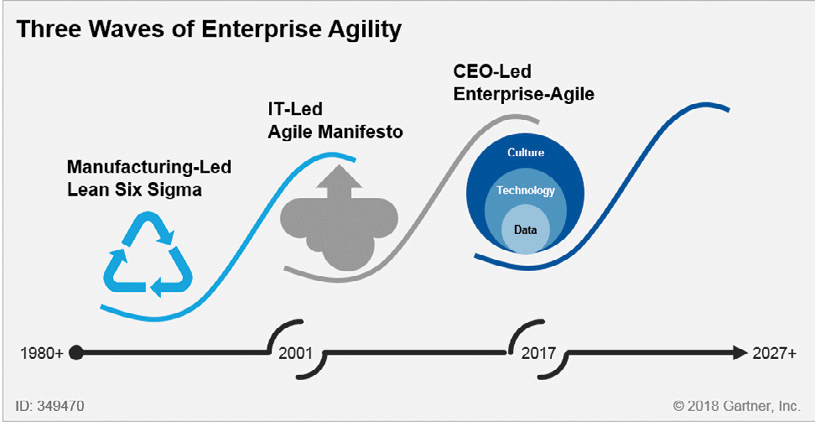THANK YOU FOR SUBSCRIBING
Editor's Pick (1 - 4 of 8)

The Third Wave of Enterprise Agility Making Digital Transformation Work in Established Organisations
Jenny Beresford, Senior Research Director, Gartner


Jenny Beresford, Senior Research Director, Gartner
Third wavers confidently experiment to reform their trinity of organisational assets: culture, technology and data
 Third wavers find and appoint business and technology leaders who’ve experienced one or more transformation attempts. They have the “scars” and acumen acquired designing, leading and participating in conscious organisational change. Such leaders are evolved digital business leaders who are willing to ride the tumultuous waves of change with the CEO.
Develop a transformation roadmap
Many established organisations have heard the call for change to remain competitive in a disrupted business environment. Few are successfully moving swiftly and effectively enough to make sense of the 21st century business model and retrofit an appropriate design in their enterprise. Even when they’ve exceptional leadership with a bold vision, the task of harnessing and turning the business is proving difficult. However, enterprises that are becoming new world digital businesses start with a loose, principle-based roadmap traversing culture, technology and data.
Adopt agile principles
The third wave of organisational change appropriates and applies agile principles and practices top-down and bottom-up to enable deep rich cross-functional collaboration, fluid communications and rapid flow of idea to action.
Traditional siloed structures are flattened and recast to look more like a network of teams than a hierarchy. An agile practice discipline of continual, enterprise-wide prioritisation across a backlog or portfolio of potential investment, balances limited funds, effort, time and resources across limitless ideas, projects, and activities.
This helps third-wave organisations move more quickly towards their shared objective of digital business transformation. Productivity and velocity increases incrementally as the transformation gains assurance and validity from even small, early results. The change is experiential.
What does success look like?
During the first year of its transformation,BNPPF’s leaders said people were flourishing and developing themselves. Its new governance model has changed the approach to IT demand management and priority alignment across business units. Business trust and engagement with IT is slowly shifting. The bank is now starting to protect and use dynamic, constantly flowing, distributed data that digital business generates, which leads to the creation of digital products.
Overall, executives say the major change is its ability to scale its digital business model. BNPPF was declared "Bank of the Year — Belgium" in November 2017 by The Banker magazine.
Established organisations successfully adapting to digital business conditions can deliver growth and profit from disruption. Boards and shareholders are satisfied when they start to see these investments in change delivering traditional business measures of growth in market share, then revenue, and finally, margins.
Third wavers find and appoint business and technology leaders who’ve experienced one or more transformation attempts. They have the “scars” and acumen acquired designing, leading and participating in conscious organisational change. Such leaders are evolved digital business leaders who are willing to ride the tumultuous waves of change with the CEO.
Develop a transformation roadmap
Many established organisations have heard the call for change to remain competitive in a disrupted business environment. Few are successfully moving swiftly and effectively enough to make sense of the 21st century business model and retrofit an appropriate design in their enterprise. Even when they’ve exceptional leadership with a bold vision, the task of harnessing and turning the business is proving difficult. However, enterprises that are becoming new world digital businesses start with a loose, principle-based roadmap traversing culture, technology and data.
Adopt agile principles
The third wave of organisational change appropriates and applies agile principles and practices top-down and bottom-up to enable deep rich cross-functional collaboration, fluid communications and rapid flow of idea to action.
Traditional siloed structures are flattened and recast to look more like a network of teams than a hierarchy. An agile practice discipline of continual, enterprise-wide prioritisation across a backlog or portfolio of potential investment, balances limited funds, effort, time and resources across limitless ideas, projects, and activities.
This helps third-wave organisations move more quickly towards their shared objective of digital business transformation. Productivity and velocity increases incrementally as the transformation gains assurance and validity from even small, early results. The change is experiential.
What does success look like?
During the first year of its transformation,BNPPF’s leaders said people were flourishing and developing themselves. Its new governance model has changed the approach to IT demand management and priority alignment across business units. Business trust and engagement with IT is slowly shifting. The bank is now starting to protect and use dynamic, constantly flowing, distributed data that digital business generates, which leads to the creation of digital products.
Overall, executives say the major change is its ability to scale its digital business model. BNPPF was declared "Bank of the Year — Belgium" in November 2017 by The Banker magazine.
Established organisations successfully adapting to digital business conditions can deliver growth and profit from disruption. Boards and shareholders are satisfied when they start to see these investments in change delivering traditional business measures of growth in market share, then revenue, and finally, margins.
Weekly Brief
I agree We use cookies on this website to enhance your user experience. By clicking any link on this page you are giving your consent for us to set cookies. More info
Read Also












